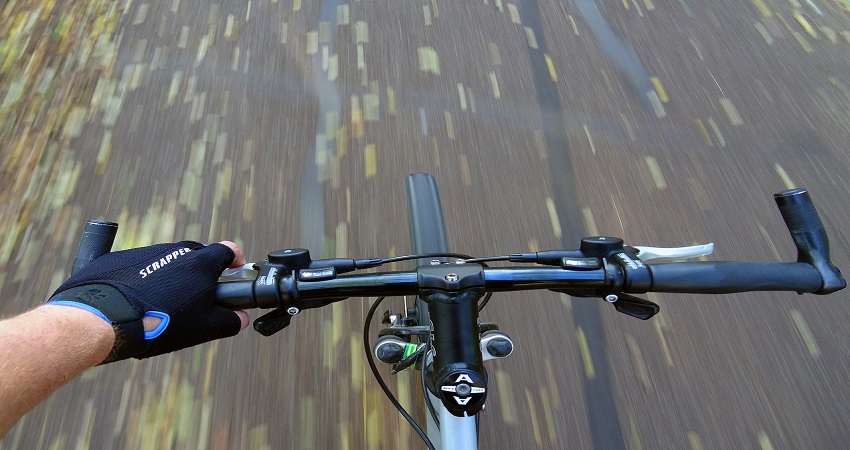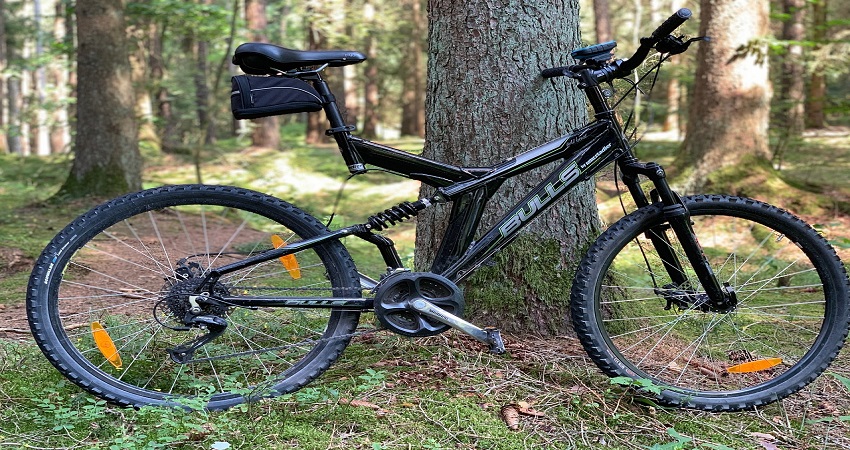Yes, mountain bike handlebars are adjustable, allowing riders to customize their riding position and comfort. Mountain bike handlebars are designed to be adjustable, enabling riders to find the most comfortable and efficient riding position.
By adjusting the handlebars, riders can tailor their riding experience to suit their needs and preferences. This flexibility is especially useful for mountain biking, as it allows riders to adapt to various terrains and riding styles. With adjustable handlebars, cyclists can easily fine-tune their bike’s fit, improving control and reducing fatigue during long rides.
So, whether it’s a casual cruise or an adrenaline-fueled downhill adventure, adjustable mountain bike handlebars provide the versatility and customization needed for an optimal riding experience.
Types Of Mountain Bike Handlebars
The handlebars on your mountain bike play a crucial role in your comfort, control, and overall riding experience. There are different types of mountain bike handlebars available, each with its own unique design and features. In this section, we will explore the various types of mountain bike handlebars and their benefits.
Flat Handlebars
Flat handlebars, also known as straight handlebars, are the most common type of mountain bike handlebars. As the name suggests, these handlebars have a flat shape and provide a more upright riding position. They are usually wider and allow for greater control and stability on technical trails. Flat handlebars are popular among mountain bikers who prefer an aggressive riding stance and better control over their bike in challenging terrain. This type of handlebar is commonly found on cross-country and trail mountain bikes.
Riser Handlebars
Riser handlebars, as the name implies, feature a riser or upward bend in the middle of the handlebar. This design offers a more raised hand position compared to flat handlebars, allowing for a more comfortable riding position and improved steering control. Riser handlebars are commonly used on mountain bikes designed for downhill, enduro, and all-mountain riding. They provide better leverage, especially when tackling steep descents and technical trails. Additionally, riser handlebars tend to absorb more vibrations, reducing fatigue on longer rides.
Drop Handlebars
Drop handlebars are primarily used on road bikes, but they can also be found on some hybrid and gravel bikes. This type of handlebar features a downward curve at both ends, allowing for multiple hand positions and aerodynamic riding. Drop handlebars provide a more aggressive riding position, improving aerodynamics and efficiency on smooth surfaces. They are not commonly used on mountain bikes, as the aggressive position and limited control make them less suitable for off-road riding.
Swept-back Handlebars
Swept-back handlebars, also known as cruiser or comfort handlebars, have a relaxed and upright riding position. They feature a backward sweep towards the rider, promoting a more comfortable and ergonomic hand position. Swept-back handlebars are commonly seen on cruiser bikes and some hybrid bikes. They prioritize comfort over performance and are not typically used on mountain bikes, as they lack the agility and control required for off-road riding.
To summarize, mountain bike handlebars come in different shapes and designs to suit different riding preferences and terrains. Whether you prefer a more aggressive stance or a comfortable riding position, there is a handlebar type that can enhance your overall biking experience.
Adjustability Of Mountain Bike Handlebars
When it comes to mountain biking, having the correct handlebar setup is crucial for both comfort and control. One of the key factors to consider is the adjustability of the handlebars. Thankfully, most mountain bike handlebars offer some form of adjustability, allowing riders to fine-tune their riding experience to suit their preferences and needs. In this article, we will explore the different types of adjustable features found on mountain bike handlebars and their benefits.
Standard Handlebar Adjustments
Standard handlebar adjustments refer to alterations that can be made to the handlebars themselves. These adjustments often involve changing the width, rise, or sweep of the handlebars.
Adjusting the width of the handlebars can have a significant impact on a rider’s control and maneuverability. A wider handlebar provides improved stability, especially on rough terrain, while a narrower handlebar offers better control for technical maneuvers.
The rise of the handlebars refers to the vertical distance between the stem and the grips. By adjusting the rise, riders can optimize their riding position and weight distribution on the bike. Higher rise handlebars are suitable for riders seeking a more upright riding position, while lower rise handlebars are favored by those who prefer a more aggressive, forward-leaning position.
The sweep, or backsweep, of the handlebars refers to the backward angle of the grips. Adjusting the sweep can make a difference in hand comfort and wrist alignment. Handlebars with more sweep offer a more ergonomic hand position, reducing strain on the wrists and improving overall comfort.
Stack Height Adjustments
Stack height adjustments are made at the stem, which attaches the handlebars to the fork steerer tube. The stack height refers to the vertical distance from the top of the headset to the center of the handlebars.
By adjusting the stack height, riders can customize their handlebar height to suit their riding style and body proportions. Increasing the stack height raises the handlebars, making it more comfortable for riders who prefer an upright riding position. On the other hand, reducing the stack height lowers the handlebars, allowing for a more aggressive, aerodynamic position.
Stem Adjustments
Stem adjustments involve altering the angle, length, or rise of the stem that connects the handlebars to the fork steerer tube.
Angling the stem can help fine-tune the rider’s body position. Some riders may prefer a more upright position, while others may opt for a more forward-leaning stance.
Changing the length of the stem can impact the bike’s handling characteristics. Shorter stems offer quicker and more responsive steering, ideal for technical trails. Longer stems provide greater stability, perfect for fast descents.
The rise of the stem also affects the overall handlebar height. By adjusting the rise, riders can find the sweet spot that balances control and comfort.
In conclusion, mountain bike handlebars are highly adjustable, allowing riders to customize their riding experience. Through standard handlebar adjustments, stack height adjustments, and stem adjustments, riders can optimize their comfort, control, and overall performance on the trails.
Benefits Of Adjustable Handlebars
Adjustable handlebars offer various benefits to mountain bike riders. They enhance comfort, improve control, and cater to individual preferences, allowing cyclists to achieve optimal riding positions for better performance.
Improved Comfort
One of the key benefits of adjustable handlebars on mountain bikes is the improved comfort they offer to riders. By being able to adjust the height and angle of the handlebars, cyclists can find the perfect riding position that suits their individual body structure and preferences. When the handlebars are properly positioned, it helps to alleviate strain and discomfort on the upper body, including the neck, shoulders, and wrists. This enables riders to enjoy longer rides without experiencing excessive fatigue or pain.
Customized Riding Position
With adjustable handlebars, riders have the freedom to customize their riding position to suit their needs and riding style. By adjusting the height and angle of the handlebars, cyclists can achieve a position that is ideal for their body mechanics. For example, some riders prefer a more upright position for leisurely rides or when climbing steep inclines, while others may prefer a more aggressive position for increased aerodynamics and optimal power transfer. Being able to adjust the handlebars allows riders to find the perfect balance between comfort and performance.
Better Handling And Control
Another advantage of adjustable handlebars is the improved handling and control they provide on the trails. By making fine adjustments to the handlebars, riders can achieve a more stable and balanced position, which enhances their ability to navigate technical terrain and respond quickly to changing trail conditions. This added control translates to greater confidence and safer riding. Whether you’re tackling tight corners, rocky descents, or technical climbs, having adjustable handlebars allows you to optimize your riding experience and maneuverability.
Considerations When Adjusting Handlebars
Adjusting handlebars on a mountain bike is a crucial consideration for a comfortable ride. Ensure a proper fit by adjusting height, angle, and width according to personal preference and riding style.
When it comes to mountain biking, the handlebars play a crucial role in ensuring comfort, control, and overall riding experience. Adjusting the handlebars to suit your individual preferences and riding style can make a significant difference in your performance on the trail. However, there are a few important considerations to keep in mind before making any adjustments. Let’s take a closer look at these considerations:
Proper Fit And Sizing
Ensuring that your mountain bike handlebars have a proper fit and sizing is essential for optimal comfort and control. The handlebars should be adjusted to match the width of your shoulders, allowing for a natural and comfortable riding position. Additionally, the height of the handlebars should be adjusted to a level that allows your arms to be slightly bent, promoting better control and maneuverability. A proper fit and sizing not only improve your riding experience but also significantly reduce the risk of discomfort and fatigue during long rides.
Bike Geometry
The bike’s geometry also plays a significant role in determining the adjustability of the handlebars. Different bikes have varying levels of adjustability, depending on their design and intended use. It’s important to understand your bike’s geometry, such as the head tube angle and stem length, as these factors can affect the adjustability of the handlebars. For example, bikes with steeper head tube angles may limit the adjustability of the handlebars, while those with shorter stems offer more room for adjustment. Understanding your bike’s geometry will help you make informed decisions when adjusting your handlebars.
Riding Style And Terrain
Another crucial consideration when adjusting handlebars is your riding style and the type of terrain you typically ride on. Different riding styles, such as cross-country, downhill, or trail riding, may require different handlebar positions. For example, a more aggressive riding style may benefit from lower handlebars, providing a more aerodynamic position and improved control on steep descents.
On the other hand, a more relaxed riding style may prefer higher handlebars for increased comfort and stability on longer rides. Similarly, the type of terrain you ride on, such as technical trails or smooth roads, may also influence the optimal handlebar position. Adjusting your handlebars to suit your riding style and terrain can enhance your overall performance and enjoyment on the trails.
Overall, when considering whether mountain bike handlebars are adjustable, it’s important to evaluate proper fit and sizing, bike geometry, riding style, and terrain. Each of these factors contributes to the overall comfort, control, and performance on your mountain bike. By understanding these considerations, you can make informed adjustments to your handlebars that maximize your riding experience. So, take the time to analyze your preferences and make the necessary adjustments to ensure the perfect handlebar position for your next thrilling mountain biking adventure!
Professional Help And Tools
Mountain bike handlebars can be adjustable, allowing riders to customize their riding position for comfort and control. Professional help and tools are available to assist in making the necessary adjustments for an optimal riding experience.
Seeking Expert Advice Finding the right handlebar position for your mountain bike is essential for a comfortable and efficient ride. When it comes to adjusting your handlebars, seeking expert advice can make a world of difference. Professionals can assess your riding style, body posture, and individual needs to recommend the best handlebar position for you. They have the knowledge and experience to ensure your bike fits you perfectly, preventing potential discomfort and injuries.
Whether you’re a beginner or a seasoned rider, seeking expert advice is always a smart move. The Importance of Bike Fit A proper bike fit is crucial for every cyclist, and handlebar adjustments play a significant role in achieving it.
When your handlebars are correctly positioned, you’ll experience better control, balance, and stability on the trails. Furthermore, a well-fitted bike enhances your efficiency and reduces the risk of strain and fatigue during long rides. Investing in a professional bike fit ensures that every component, including the handlebars, is dialed in perfectly for your body and riding style.
Useful Tools for Handlebar Adjustments Adjusting your mountain bike handlebars may require specific tools.
Here are some useful tools you might need for handlebar adjustments:
- Allen wrench set: An Allen wrench set is essential for adjusting the stem and handlebar clamp bolts. These bolts might need to be loosened or tightened when adjusting the handlebar position.
- Torque wrench: A torque wrench ensures that you tighten the bolts to the manufacturer’s recommended torque. This prevents over-tightening, which can lead to damage or failure of the components.
- Handlebar adjustment guide: Some handlebars come with adjustable features, such as width and angle. In such cases, referring to the manufacturer’s adjustment guide can help you make precise modifications.
- Bike stand: A bike stand is not directly related to handlebar adjustments but can make the process much easier. It holds your bike securely in place, allowing you to work on the handlebars comfortably.
Remember, it’s crucial to follow the manufacturer’s instructions and guidelines while using these tools. If you’re unsure about handling the adjustments yourself, it’s always best to consult a professional for expert assistance.
Now that you understand the importance of professional help and have an idea of the tools required for handlebar adjustments, you can ensure your mountain bike provides the perfect fit for your riding preferences. Seek expert advice, invest in a proper bike fit, and use the necessary tools for a comfortable and enjoyable riding experience.
Frequently Asked Questions Of Are Mountain Bike Handlebars Adjustable?
Can You Adjust The Handlebars On A Mountain Bike?
Yes, most mountain bike handlebars are adjustable. They can be adjusted in terms of height, angle, and width to provide a comfortable riding position for different riders and riding styles.
How Do You Adjust The Height Of Mountain Bike Handlebars?
To adjust the height of the mountain bike handlebars, you can loosen the stem bolts, raise or lower the handlebar, and then tighten the bolts back. It’s important to find the right height that suits your body posture and riding comfort.
What Is The Benefit Of Adjustable Mountain Bike Handlebars?
Adjustable mountain bike handlebars allow riders to customize their riding position for improved comfort and control. By adjusting the height, angle, and width of the handlebars, riders can optimize their body posture, reduce strain on their wrists and shoulders, and enhance their overall riding experience.
Conclusion
Mountain bike handlebars can be adjustable to fit individual rider preferences and riding styles. By adjusting the width, rise, and sweep of the handlebars, cyclists can find the optimal position for comfort and control. However, it’s important to consult with a professional or experienced rider for guidance to ensure proper bike fit and avoid any potential discomfort or injury.
Understanding the adjustability options available can enhance your mountain biking experience and improve overall performance on the trails. So, go ahead and fine-tune your handlebars to conquer every ride with confidence.



